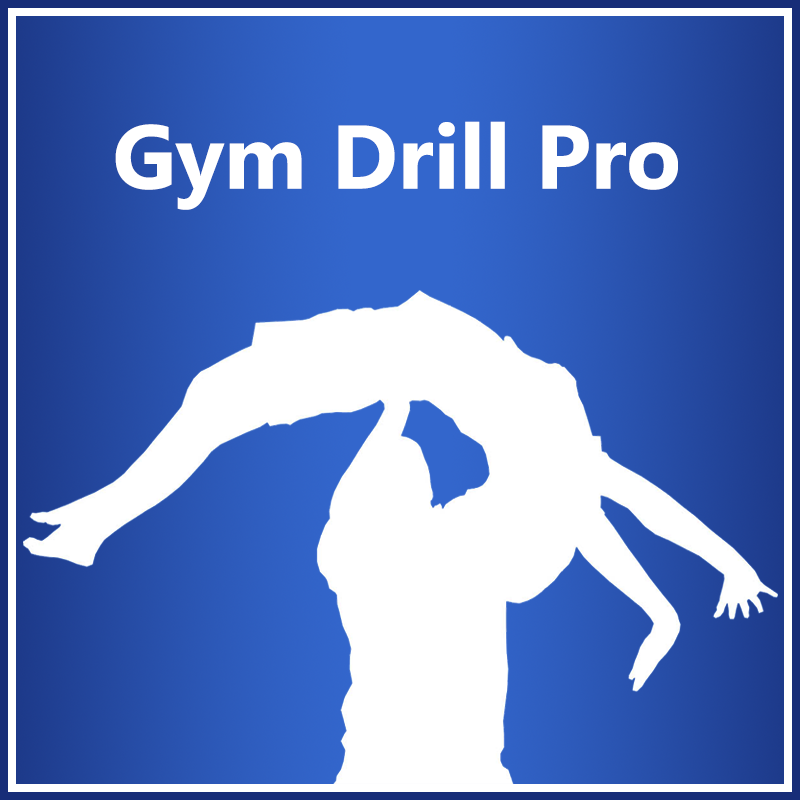

In gymnastics, the floor refers to a specially prepared exercise surface, which is considered an apparatus. It is used by both male and female gymnasts. The event in gymnastics performed on floor is called floor exercise. The English abbreviation for the event in gymnastics scoring is FX. A spring floor is used in most competitive gymnastics to provide bounce. Spring floors are also used sometimes in cheerleading. The sprung floor used for indoor athletics, however, is designed to reduce bounce. The apparatus originated as a 'free exercise' for men, very similar to the floor exercise of today.It wasn't until 1948 that women were allowed to compete on the floor. Most competitive gymnastics floors are spring floors. They contain springs and/or a rubber foam and plywood combination which make the floor bouncy, soften the impact of landings and enable the gymnast to gain height when tumbling. Floors have clearly designated perimeters—the "out of bounds" area is always indicated by a border of white tape or a differently colored mat. The allowed time for a floor exercise is up to 70 seconds for males and up to 90 seconds for females. Unlike men, women always perform routines to music. (Wikipedia)
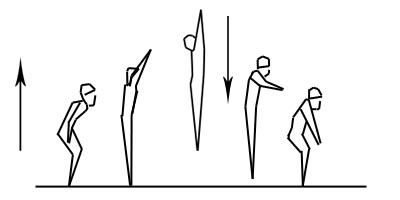
The skill starts in a standing position, with the arms up. The gymnast should bend their legs and at the same time, lower their arms. Extend the legs explosively, and at the same time raise the arms up, performing a high straight jump from standing. During the landing, the gymnast should bend their legs and lower their arms to the level of their chest. During the flight, the body is straight, the head is in the middle position. A modification of this skill is a Tucked Jump (floor level #4 routine). In this skill, during the regrouping, the knees should approach the chest in a tight tuck.
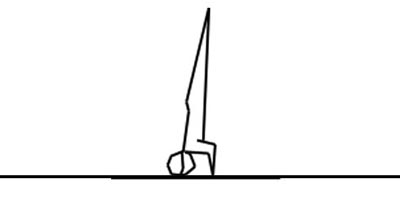
From a squat position, the gymnast should form a triangular shape with their hands and head (their head should be the top of the triangle, with their hands acting as the bases). The gymnast’s forehead should touch the floor, not the top of the head. The gymnast should slowly lift their legs from a tucked position and then extend their hips and legs to balance in an extended headstand. Support and balance are provided by the arms.
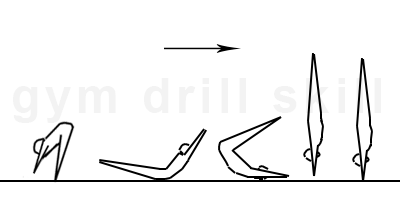
The back extension roll is a very important drill for back giants on rings, parallel bars, and high bar. It helps the gymnast to maintain a hollow body position, without leading with the hips up to handstand. At the same time, it improves their ability to push back with their arms.The skill begins in a standing position with the arms up. The gymnast should lower the upper body to the ground, the hands should almost be touching the floor. This piking position initiates the back roll. The back should be round. When the arms reach the floor, the gymnast pushes back strongly, and at the same time directs the legs up to vertical. The push back of the arms against the floor should be extremely strong and powerful. If the performance is done well, the gymnast can hand a hand hop at the end of the move during the handstand position. During the entire execution, the arms and the legs should be tight. A very common mistake is kicking up from the hips. The move should be done entirely in a hollow position with the gymnast leading their body into handstand from their toes.
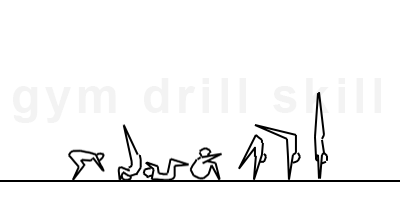
A Forward Roll Pike Handstand helps the gymnast to straighten their shoulders. This motion can then be used for all modifications of a press to handstand. This drill is a modification of a forward roll and press to handstand. It begins with rolling forward, in squat position. The gymnast should then place their hands on the floor, push off the ground with their legs (feet) and raise them up to handstand. During the moment of the press, the angle of the shoulders should be completely straight. The legs are tight and together. The skill finishes in a handstand.

There are several modifications of the Scale. The two primary ones are lateral or frontal scales. Both can be performed with the raising leg being held above horizontal or up to vertical, and with the raising leg being held or not. The most common scale is the frontal scale. It starts in a standing position with the arms up. The gymnast then makes a step and lunges on the standing leg. The arms should lower to the lateral horizontal position. Then the back leg raises above the horizontal position. It’s very important to first raise the leg, then lower the body afterward. The skill finishes when the upper body lowers to horizontal and the raised leg is above horizontal. The arms should stay sideways at shoulder height.
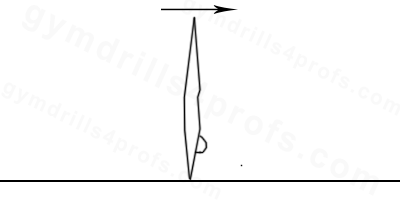
A handstand involves holding a tight body position in an inverted vertical position, balancing on one’s hands. The most basic form of a handstand involves the arms and legs being completely straight. The feet should remain together, while the hands should be roughly shoulder width apart. This makes balancing easiest when remaining in a stationary position (no walking). During the handstand, the butt and core should be tight, and the head should be in a neutral position, with the eyes watching the hands. It’s very important not to watch the hands with the head back, as this can lead to arching through the entire back. The shoulder angle should be completely straight, and the body should be stretched. As the handstand improves, more difficult modifications of the skill can be performed.
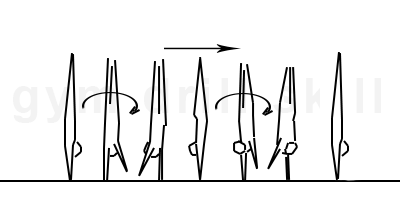
A handstand full pirouette is divided into two identical half turns. Each half turn should be done through two-quarter turns. The gymnast turns around the base arm with one quarter turn. Then they should switch the arms and have the other arm perform another quarter turn. Then the gymnast repeats the same move, concluding the full turn. There are several modifications of the turns (rotations). In the first one, the gymnast does an entire half turn with one hand motion. Then performs the second turn in the same way. This is useful for teaching a pirouette on single rail events like high bar and uneven bars. The second modification involves the gymnast performing two quarter turns during each half of the full rotation. This is useful in teaching the gymnast more control during their handstand, and for teaching a pirouette on parallel bars, where half turns with one hand motion are not possible. The half turn could be performed vice versa too - in the first quarter the arm moves backward, and during the second quarter, (in opposite), the second arm is moving forward. During the execution, the body should be entirely straight. A common mistake involves the gymnast breaking the body position from the hips.
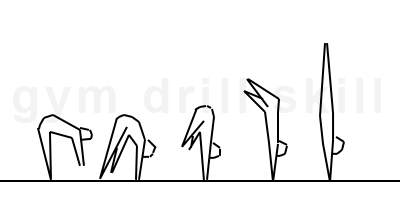
Place hands on the floor at the width of the shoulders. Legs are open in straddle, slightly wider than the position of the hands. The gymnast should be on their tippy toes and transfer their body weight onto the arms. When the feet take off from the ground, the legs should raise sideways and unite in a handstand. During the performance do not break the shoulder angle. The legs and arms should be tight. The head is slightly open, following the hands.
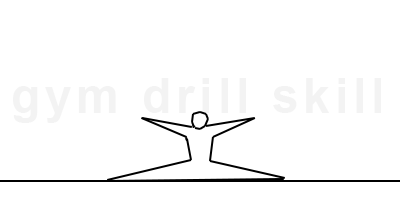
A split is a demonstration of exceptional hamstring and anterior hip flexibility. The goal of a split is to lower the body so that the legs are at an 180-degree angle, parallel to the floor. Splits can be used as a stretching exercise or warm-up for the leg muscles. This body position is very important for a number of skills in gymnastics, and can make progressions much easier (flairs, endos, jumps, etc.). It also helps to prevent injury by improving the range of motion for certain muscle groups. Splits should be practiced frequently, ideally every day for 5-10 minutes. There are several variations of a split: right leg, left leg, and middle. It’s necessary to practice each of these positions until the gymnast can reach the floor. Once this goal has been achieved, the gymnast can gradually begin to practice an oversplit by placing their legs on an elevated surface like an 8 inch or panel mat.
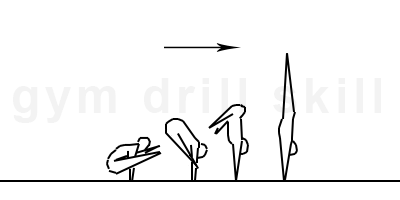
From a straddled L-sit on the floor, place the hands at shoulder width, tighten the arms and raise the straight legs over horizontal. Begin to raise the legs in a straddled pike position and simultaneously clean the shoulder angle. When reaching the vertical with the arms, shoulders and the body are in one line, gradually begin to raise the legs and finish in a handstand with the legs together. During the execution of the skill, the legs and arms are completely tight.
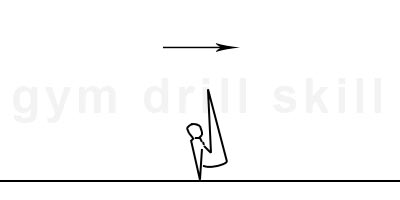
In order to perform a V-sit, the gymnast should start in an L-sit support. They should raise their legs further and compress their body into a tight piked position. This skill should be held for a minimum of 2 seconds. The gymnast’s arms and legs should be completely tight. The head should be a neutral position.
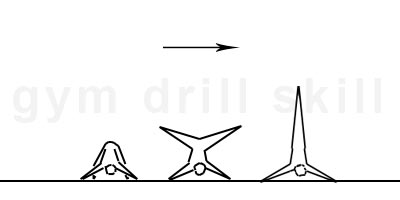
The Japanese Press Handstand (also known as a wide-arm press handstand) is an intermediate balancing and strength skill. The skill starts from a staddled pike position, with the athlete placing their hands significantly wider than shoulder width. The fingertips should be pointed out to the side so that they are in opposite directions from the other hand. This skill requires more strength than a typical press handstand. The performance of the skill is very similar to a regular press handstand. The shoulders should be extended, and the gymnast should begin the press on their tippy toes. When the hips are raised and the shoulder angle is straight, the legs should be raised sideways. During the handstand, the body will be slightly arched. The gymnast should keep their head slightly open in order to watch the floor. The hands should be open enough so that the head is roughly 1-2 inches above the ground.
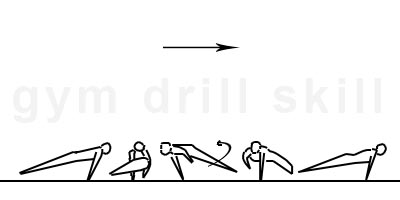
The Russian circle on the floor is a modification of the Russian circle on the pommel horse. The gymnast should be confident with the skill on both mushroom and horse. The skill begins from a standing position. The Russian circle should start and finish squarely in front support. There should be a 360 degree turn in one circle (this should be accomplished with 4 hand placements). Starting from the beginning, the first arm should reach forward to the third quarter. The second arm then reaches fast to the second quarter. At that moment, the gymnast should be done with the first half of the Russian circle in front support. The next half of the skill is the same as the first, with the athlete finishing the Russian in front support with a full turn. The hands are placed at the first quarter and fourth quarter respectively. During the performance, the body position should be slightly arched. The arms push away on the floor and the legs should be raised above the ground.
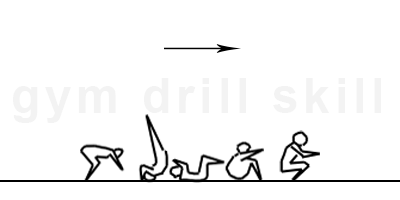
The gymnast should start in a standing position. They should squat down and place their hands on the floor. As they do this, they should tuck their head down, and perform the forward roll. Their back should roll onto the floor smoothly from the neck to their buttocks. They should finish the skill in a squat position and immediately extend their legs to a stand.
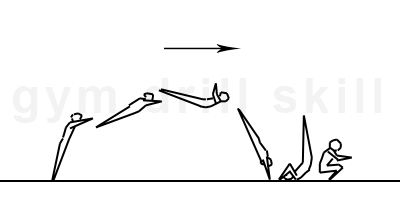
To perform a dive roll, the gymnast should run, gradually increasing their speed. They should punch off the floor with their legs tight and feet together. They should jump into the air with a straight body. At the moment of the punch, the gymnast’s arms should do a back circle and swing upwards. This arm motion will help to increase the height of the jump. After the jump the gymnast should arch their body slightly while kicking their legs backwards. They should keep their chin up with their arms slightly bent out to the side. The kick from the gymnast’s heels will help to flip them forwards. When the gymnast reaches the floor, they should be in a nearly vertical position. They should bent their arms slightly, roll forward and stand up.
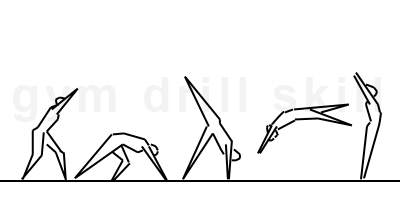
From the hurdle, the lunge should be deep enough that the hands contact the floor while the front leg is in the lunge position. There should be a strong kicking action from the back leg and a strong push of the front leg from the lunge. The general body shape during the blocking action of the front handspring should be hollow. The trajectory of the rebound off of the hands should be well beyond vertical. The kick of the back leg will help to initiate strong rotation. At handstand both legs should be already together. The shoulders and upper chest should remain open as the hands leave the floor. These actions should combine to create a strong linear velocity and maximized rotation around the center of mass. The body should remain in an extended tight arch and turned over with the feet behind the hips for the take-off of the next skill.
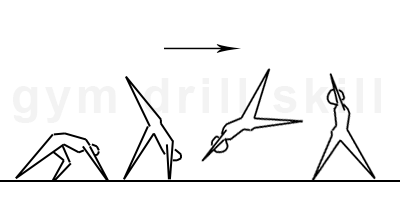
The front handspring step out is a modification of a regular front handspring. The difference between the two skills is that in the vertical position the legs are not going to be united, but the gymnast should keep them open as much as possible. The landing should be performed with the leading leg as far behind the body’s center of mass as possible in order to accelerate into the lunge for the subsequent handspring.
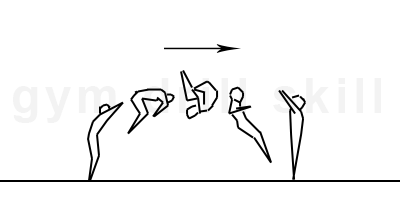
A front tuck flip is usually performed after a modest run. The last step of the run should be the hurdle. During the hurdle, the arms should be doing a circle sideways, from downward to upward. The arms should finish over the shoulders. The head should be in a neutral position with the body extended, slightly arched, with the hips forward. The gymnast should jump from their toes, with their feet together. During the flight (until vertical), the gymnast should regroup their body. The legs should be bent and moving backward, at the same time the upper body and the arms should be following the legs. The gymnast may hold their legs, but this is optional. From the vertical position (at the highest point in the flip), the body should begin extending and preparing for the landing. The head should be in a neutral position. At the landing, the arms should be bent in front of the chest.
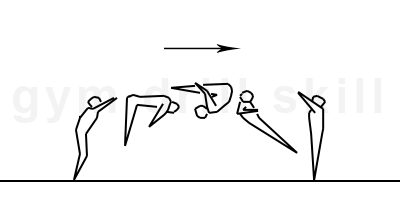
The front piked somersault is a modification of a front flip in a tucked position. A front tuck flip is usually performed after a modest run. The last step of the run should be the hurdle. During the hurdle the arms should be doing a circle sideways, from downward to upward. The arms should finish over the shoulders. The head should be in a neutral position with the body extended, slightly arched, with the hips forward. The gymnast should jump from their toes, with their feet together. During the flight the legs are tight and moving backwards. The upper body follows the legs. The gymnast should hold the legs for a better regrouping. The piked flip could be performed without regrouping, but in this case, the flip is usually slower. Before the landing (when the athlete is around horizontal), they should open their body and land in a standing position.
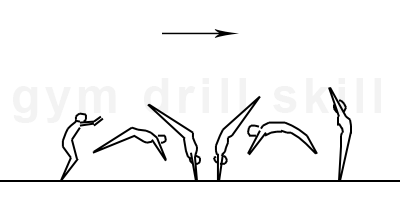
A bounder is very similar to a front handspring in terms of body positioning and shape. The main difference between the two is that a bounder is done with the feet together for the entire skill. During the beginning of the skill, the body should be hollow as the gymnast jumps to their hands. The next part of the skill involves the gymnast pushing their body into a tight arch in order to create rotation. There should be a rebound from the hands during the third part of the skill. The gymnast can do this by kicking back with tight legs and executing a strong blocking motion against the floor. When landing, the gymnast’s feet should be slightly in front of their hips. The gymnast should maintain an arched body with their head up, chest open, and arms behind their ears.
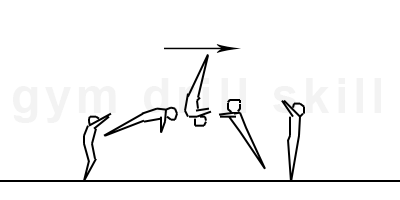
Run forward and jump from the toes, lift your arms up sideways during the hurdle. At the moment of the bounce with bent arms over the shoulders, lower them shorty in front of the chest almost tight and at the same time lean up slightly in a hollow position from the body. Eyes look straight forward. Jump off and immediately kick back the legs from the heels. During the flight the body should already be slightly arched, the head should be back and the arms should spread to the sides. During the landing, the body transforms into the starting position, ready for the landing, or for rebounding. Doing it this way is optimal for front layouts in connection with other skills, and as a drill for front handsprings on vault. For layouts with twisting, the gymnast should perform a different kind of front layout. Instead of performing a low, long, and fast flip which helps to accelerate tumbling sequences, the gymnast should strive for a higher, potentially slower layout. For this modification of the flip, the arms should remain bent during the take-off and stay over the shoulders. The other difference is that the body should be straight, not leaning forward during the take-off. During the flight, the gymnast should be less arched and more straight. The arms should be bent, close to the body around shoulder height. This will allow the athlete to prepare for twisting.
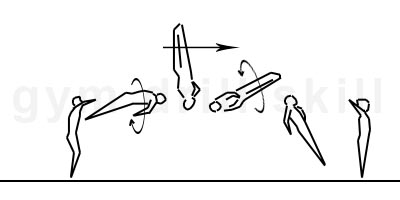
There are several variations of front flip full twist. The skill could begin from a run, front handspring, or in connection after a previous flip. This skill can be done by first assuring that the rotation is adequate, and then executing the twist afterward. The gymnast should rebound upward with the arms raised bent over the shoulders. After the first quarter of the rotation, the turning move should be initiated with the elbow of the leading arm. The arm should cross over the chest with the second arm following in the same direction. The execution of the skill can be performed correctly when the twist starts simultaneously with the rotation. At the moment of the bounce off the floor, the body should be straight and slightly arched from the hips. The twisting should begin after the initial flip rotation has been accomplished. The twisting should begin from the opposite of the rotation hip. During the flight in the second half of the twist, the gymnast should slightly delay the turn from their upper body. The purpose of this is so that they watch the floor and can land arched. The rotation stops when the arms lift away from the chest. At the landing, the athlete could continue with a bounce for another flip or simply land. There are two ways to perform this flip too. At the moment of the bounce, the shoulders can lean up with the body slightly piked from the hips. This allows the flip to become longer and faster. This modification is suitable for flips in connection. In the other scenario, where the front flip twist is the final element of the pass, the gymnast should jump upward in a vertical position during the rotation so that the body is straight and slightly arched.
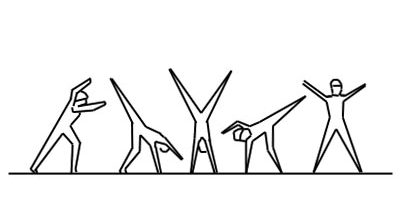
The starting position is from standing with the hands up. The gymnast does a step, then a lunge and puts their first hand sideways in front of the lunging leg. The back leg kicks strongly back overhead. Next, the gymnast places the second hand in the same line as the legs and the first hand, the gymnasts passes through the handstand sideways in a wide open straddle. The rotation continues. The gymnasts places the first foot on the floor, then the other one and finishes standing up in a straddle with their arms overhead. The entire rotation should be performed on one line. The shoulders and hips should be extended for the entire duration.
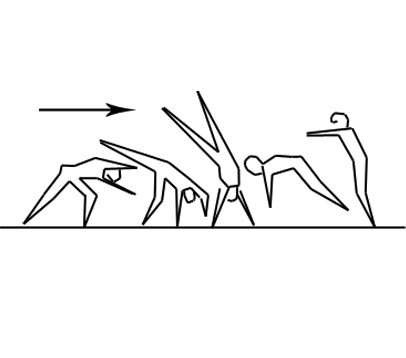
The gymnast should start with their hurdle, raising their arms up and opening their shoulder angle. Their back leg should perform a strong kick backward. Their lunge leg should push down on the floor. As they lean forward, they should twist their first hand 1/4 before reaching the floor. The hand placement should not be excessively close or far from the feet. The lunge leg follows the back leg, where they should close together by the time the gymnast reaches handstand. At the same time, the gymnast should continue twisting around their first arm until the second hand is placed down. This second hand should be turned an additional 1/4. Next follows the snap down. The gymnast’s body should release in hollow, with their arms extended around horizontal. Their head should be between their arms, with their feet in front, ready for a back handspring or tempo salto. In the case of a backflip after the roundoff, the legs should arrive slightly back instead of vertical. The arms should be overhead with the head in a neutral position. The hips should be in and the body should be in a slightly arched position.
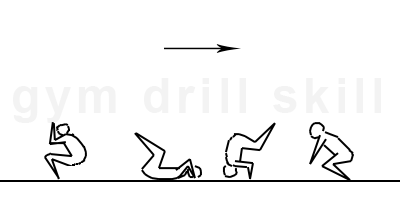
The backward roll is more difficult for the gymnast than the forward roll because the rotation is going backward, there can be a lot of pressure on the neck. Neck flexibility and proper placement of the hands against the floor are necessary for avoiding injury to the neck. Backward rolls are particularly difficult for very young gymnasts because of their body proportions. The proper starting position in gymnastics is to first stand up with the hands above the head. The gymnast lowers their body in a piked position and bends their legs into a squat stand. The head should be tucked to the chest, with the back rounded. The arms should remain above the shoulders. The gymnast should roll backward by dropping their buttocks to the floor and bringing their legs up over their head. Their hands should be placed on the floor, around the head. The pushing begins with the hands and arms when the tucked body is in vertical before the feet contact the floor. The rotation finishes in a squat stand, then the athlete stands up and raises their arms up above their head. Technically, the skill can start from a tucked stand, straddle, pike, or sit. Some common errors are rolling over one shoulder, a lack of push from the hands, an uneven push with the hands, failure to stand, and a lack of body control (loose). During the learning process, the coach might provide assistance, holding them by the hips, and pushing their back.
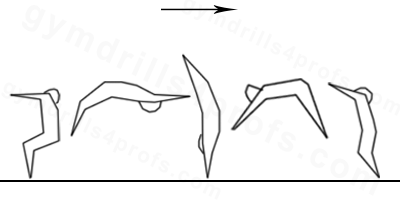
A back handspring usually begins from a round-off, second back handspring, or tempo-salto. Its purpose is for accelerating the tumbling speed in order to end the pass with a backflip skill. The starting position begins with a deep hollow position, with the arms over the head. The chin should be down with the hips tucked. The legs are slightly bent and in front of the hips. The gymnast should jump backward and kick back with tight arms. They should arch their body until their hands reach the surface of the floor. As soon as the gymnast touches the floor, the body should be in a tight arch, slightly before the handstand position. Next follows a strong whip, which will bring the legs to the floor much faster. The wrists should push back aggressively onto the floor until the end of the fingers. The gymnast performs a snap down during the flight until they land on their feet. In order to perform the following skill, the ending position should be equal to the starting position. Or in the case of a flipping skill, the ending position should be slightly arched with extended hips, tight legs, and arms over the shoulders.
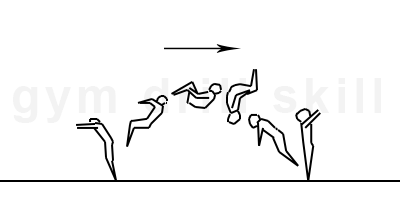
During the upward bounce, the arms should be raised aggressively above the shoulders with an open chest and shoulders. The hips should be extended, the body straight, with a slight arch. The gymnast should jump strong, pushing on the floor until he/she is on their tippy-toes. During the flight, the knees should lift and bend towards the belly, with a pike from the hips. The head should be in a neutral position. Raising the hips helps to accelerate the backward rotation. During the flip, the arms should be executing a back circle, the gymnast should then grab their legs. Prior to the landing (around horizontal), the body should open into a stretched position.
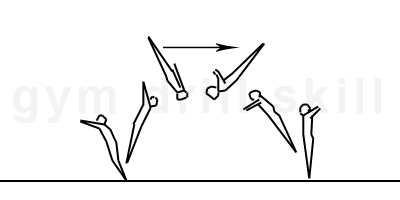
From the snap down phase of the back handspring (or whip back salto or round off) the body should contact the floor in a tight body, slightly hollow position, the arms reach dynamically overhead with chest and shoulders open, head neutral and body stretched vertically to full extension. The gymnast should then lift the hips and legs forcefully upward with no backward lean. The body remains stretched as the rotation continues toward vertical turning over. As the turnover action reaches its peak the chest continues to lift adding to the rotation. The body remains tight and stretched as the gymnast prepares for landing.
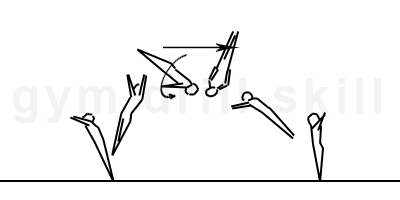
The correct execution of the full twist layout relies on a correct back layout. After the snapdown, the gymnast should raise their arms fast. The leading arm should be bent at the level of the head and the elbows behind the back. The supporting arm should be bent, over the shoulders. The body should be extended, slightly arched from the hips, and the hips should be slightly twisted, following the leading arm. The head should be in a neutral position. The gymnast leaves the floor at the vertical position, jumping from their toes. The twist starts from the leading side of the hip. For example: if the gymnast chooses to turn on their right side, then the leading hip is the left, and the gymnast should lean slightly on the right side. During the twist, the body should be straight and slightly in a hollow. At the last quarter of the flip, when the gymnast is around the horizontal, the full twist should already be concluded. The body is slightly arched and the arms should raise around the level of the chest in preparation for the landing. At the landing, the arms should be bent in front of the chest.
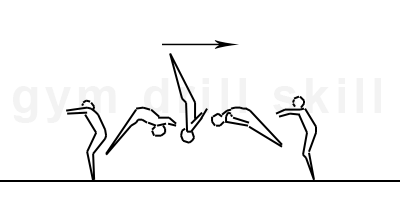
The technique of the whip back is very similar to a back handspring. The whip back should be initiated from a hollow body position with an arm swing to a full body extension with a tight upper back and shoulder arch. After passing vertical, the arms swing down as the body shapes to a hollow position (chest rounded and hips tucked under). The landing should return to the hollow position with arms at horizontal ready to swing to the next skill.
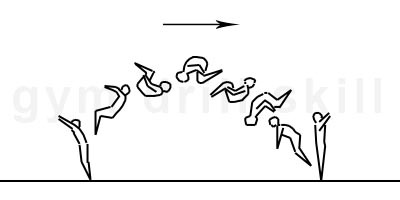
During the upward bounce, the arms should be raised aggressively above the shoulders with an open chest and shoulders. The hips should be extended, the body straight, with a slight arch. The gymnast should jump strong, pushing on the floor until he/she is on their tippy-toes. During the flight, the knees should lift and bend towards the belly, with a pike from the hips. Immediately after the bouncing, the athlete should grab their legs in tucked position.There are two ways of holding the legs. In the first method, the gymnast lowers the arms and catches at their knees. In this case, it’s faster, because the route of the hands is shorter. The downside is that lowering the arm in this way is a counter move. After catching the knees, the hands are pulling the knees in and up, in order to increase the speed. Another way of catching the legs is to have the arms grab the hamstrings after performing a backward circle. The route for the arms is longer, but they naturally follow the motion of the flip. This can easily accelerate the rotation speed. Prior to the landing (around horizontal), the body should open and the arms should raise in front of the chest.
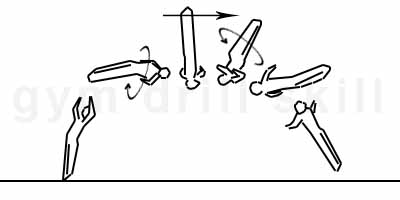
This skill starts from the snap down of the back handspring, round off or whip. The bouncing from the floor should start before the vertical, the body should be slightly arched. The arms should be at the level of the shoulders, the leading hip should be slightly twisted. Actually, the hip should give the direction and the acceleration to the rotation. During the rotation, the body should be extended with the head in the middle position and slightly in. the twisting part should be concluded around the third quarter of the layout. Prior to the landing, the gymnast opens the raises their arms over the shoulders, which prevents them from continuing the twist. A very important topic for the skill is the moment of the bounce. The body should be slightly arched, before vertical, with the leading hip twisted.
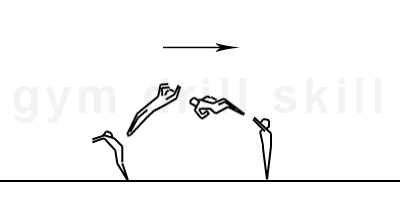
After the snapdown, the gymnast should raise their arms fast. The leading arm should be bent at the level of the head and the elbow behind the back. The supporting arm should be bent, over the shoulders. The body should be extended, slightly arched from the hips, and the hips should be slightly twisted, following the leading arm. The head should be in a neutral position. The gymnast leaves the floor at the vertical position, jumping from their toes. The twist starts from the leading side of the hip. For example: if the gymnast chooses to turn on their right side, then the leading hip is the left, and the gymnast should lean slightly on the right side. Upon reaching vertical, the body should be shortening, and after vertical (concluding the rotation), the gymnast should immediately extend in preparation for the landing. The head should be in a neural position. At the landing, the arms should be bent in front of the chest.
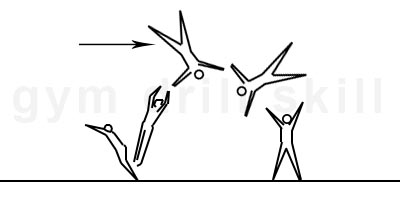
The proper execution of the side flip stretched relies on a correct back layout. After the snapdown, the gymnast should raise their arms fast. The leading arm should be bent at the level of the shoulders and the elbow behind the back. The supporting arm should be bent, over the shoulders, around the level of the head. The body should be extended, slightly arched from the hips, and the hips should be slightly twisted, following the leading arm. The head should be in a neutral position. The gymnast leaves the floor at the vertical position, jumping from their toes. The twist starts from the leading side of the hip. For example: if the gymnast chooses to turn on their right side, then the leading hip is left, and the gymnast should lean slightly on the right side. During the flip, the body should be straight with wide open legs. The gymnast should not perform additional twists during the flight. The initial action of the arms and the hips at the moment of the bounce should be enough for the subsequent quarter turn. During the rotation, the body should be in an exact sagittal plane. The landing is lateral, with open legs and the arms should be sideways at horizontal.
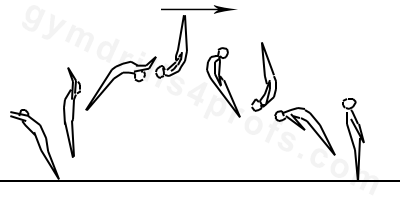
For the double back layout, the technique of the bounce is very important. The skill should be initiated from the snap down phase of the back handspring with an extremely strong back arm swing to a full body extension, with a tight upper back and shoulder arch. Compared to the tempo salto, the hips should be before the vertical axis, which will help give the flip some height. If the hips are at the vertical axis or behind, then the performance will long and low, the speed will not be transformed into the height. If the bouncing is correctly executed, the second layout should be higher than the first one.
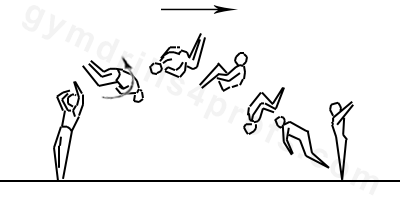
This skill starts from the snap down of the previous skill, usually a back handspring. There should be a strong drive, with an arch from the body and a turning motion from the leading hip. The body and the hips should be upright, before the vertical. If the body leans back from the hips in vertical and behind, the flipping part becomes long and low. The gymnast will not transform the horizontal speed into the height. That's why the hips at the moment of the bounce should be before the vertical position. The turned leading hip gives direction to the full twist. There are two ways of twisting in the flight, so-called “Tsukahara”. The first is to perform the full twist during the first flip (full-in-back-out). The other method is to have each flip contain a half twist (half-in-half-out). There is also another slightly less common way of performing the full twist. This method involves containing the entire twist to the second flip (back-in-full-out). In this case, the gymnast should not turn their leading hip during the bounce.
An integral part of the gymnastics coaching process is to provide athletes with drills to aid in their skill development. Drills can help gymnasts learn skills faster, and with the correct techniques. Gym Drill Pro aims to provide qualified coaches with a variety of teaching methods which they can introduce in their own training programs. On Gym Drill Pro you can find hundreds of detailed descriptions and accompanying images for every skill progression. This website is explicitly intended to support qualified coaches in their daily coaching processes. DO NOT practice any of these drills without the guidance of proper professionals.